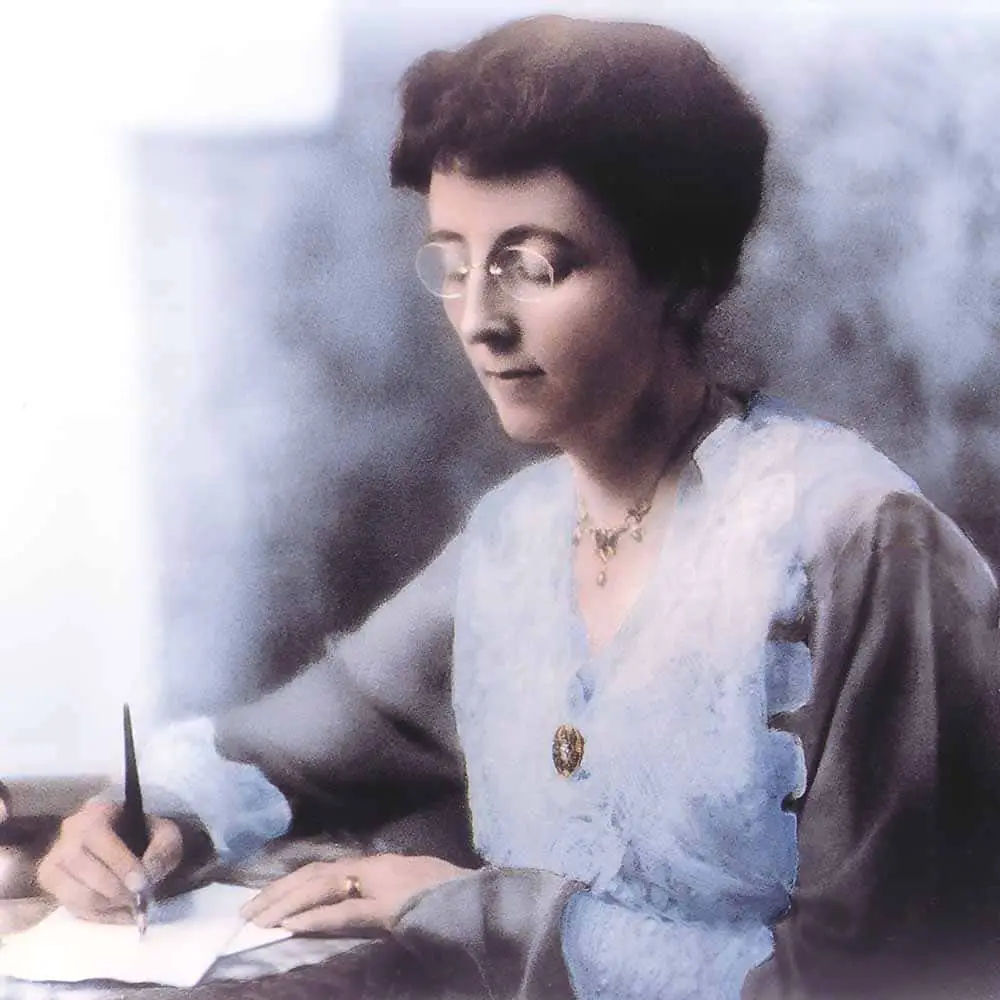
Lucy Maud Montgomery: The Life and Legacy of Canada’s Literary Icon
Born: November 30, 1874
Died: April 24, 1942
Country: Cananda
Notable works: Anne of Green Gables, Rilla of Ingleside, Emily of New Moon
Lucy Maud Montgomery, celebrated for her contribution to Canadian literature, was born on November 30, 1874, in New London, Prince Edward Island. Her legacy is deeply intertwined with the creation of Anne Shirley from Anne of Green Gables, a character whose adventures against the picturesque Prince Edward Island backdrop have enchanted readers globally with their charm and resilience.
Despite the acclaim her novels received, Montgomery’s life was a tapestry of personal challenges that subtly influenced her storytelling. After losing her mother at a young age, she was sent to live with her grandparents, embedding early in her a sense of longing and perseverance that echo through her narratives. Her journey to literary recognition was not without its hurdles. Before the success of Anne of Green Gables in 1908, Montgomery faced rejections and worked various jobs, including teaching and journalism, showcasing her commitment to her literary aspirations.
Montgomery’s oeuvre, characterized by vivid natural landscapes and spirited female leads, transcends the status of classics, offering insights into her era’s societal norms. With over 20 novels, numerous short stories, poems, and essays to her name, Montgomery has cemented her status as a formidable figure in literature, whose works continue to resonate in modern culture.
1. Early Life and Education
Lucy Maud Montgomery, acclaimed for her Anne of Green Gables series, was born on Prince Edward Island, Canada, where she received her early education and influences that profoundly impacted her literary career.
1.1. Family Background
Montgomery was born on November 30, 1874, in Clifton (now New London) on Prince Edward Island to Hugh John Montgomery and Clara Woolner Macneill. After her mother’s death, when Montgomery was only 21 months old, her father moved to Saskatchewan, leaving her in the care of her maternal grandparents in Cavendish.
1.2. Formative Years
Her childhood was spent predominantly in Cavendish with her extended family, a period that shaped much of her future writing. Montgomery’s experiences on Prince Edward Island, the rural community and its natural beauty, became a pervasive presence in her literary creations, allowing readers a glimpse into the idyllic landscapes of her early life.
1.3. Academic Pursuits
Montgomery proved to be a determined student; she attended Prince of Wales College in Charlottetown, earning a teacher’s license. Later, she briefly continued her studies in literature at Dalhousie University in Halifax, Nova Scotia, for one year (1895-1896). Although her time at Dalhousie was short, it was a period that honed her writing skills and provided material and inspiration for some of her later characters, enriching her literary repertoire.
2. Literary Career
Lucy Maud Montgomery’s literary journey is marked by significant success, notably through her seminal work Anne of Green Gables, which cemented her status as a pivotal Canadian author. Her extensive body of work, including novels, short stories, poetry, and journals, reflects a unique style and themes drawn from her life experiences.
2.1. Anne of Green Gables Success
The 1908 publication of Anne of Green Gables catapulted Montgomery to international acclaim, making the novel an enduring classic. Its global impact, evidenced by translations, media adaptations, and the thriving tourism industry at Prince Edward Island’s Green Gables heritage sites, underscores the novel’s profound cultural resonance. The series, chronicling Anne Shirley’s life in Avonlea, has not only garnered significant royalties for Montgomery but also remains a vital part of global literary heritage.
2.2. Writing Style and Themes
Montgomery’s narrative prowess, characterized by vivid imagery and a harmonious blend of realism and idealism, delves into nature, imagination, romance, and life’s everyday struggles. Her works often feature strong, independent female leads, mirroring her personal convictions and contemporary progressive trends. The Canadian rural landscape’s deep appreciation is a constant in her stories, providing a tangible sense of place.
2.3. Bibliography
Beyond the celebrated Anne series, Montgomery’s legacy is enriched by:
- Novels such as the Emily of New Moon series and The Blue Castle.
- Short story collections including Chronicles of Avonlea and Further Chronicles of Avonlea.
- Poetry and personal reflections in The Watchman and Other Poems and her published journals, offering insights into her era and personal life. The Blythes Are Quoted, her final work, awaited publication until 2009, reflecting her lasting literary influence.
3. Lucy Maud Montgomery Personal Life
Lucy Maud Montgomery’s life was a tapestry of familial joy and personal health challenges, with her journey taking her to various Canadian locales.
3.1. Marriage and Family
On July 5, 1911, Lucy Maud Montgomery wed Ewan Macdonald, a Presbyterian minister, welcoming two sons into their lives: Chester Cameron Macdonald and E. Stuart Macdonald. As a minister’s wife, Montgomery navigated the dual peaks of happiness and valleys of solitude, a role that brought both fulfillment and occasional loneliness.
3.2. Residences
Throughout her life, Montgomery’s homes were as varied as the chapters of her books. Following her marriage, she and Ewan made their home in Leaskdale, Ontario, for 15 years, a period marked by prolific writing and the birth of her sons. Their journey later took them to Norval, Ontario, and ultimately to Toronto in 1926, specifically to the Swansea area, where Montgomery lived until her passing. Each residence left its imprint on her, influencing her writing and personal experiences.
3.3. Health Challenges
Throughout her lifetime, Lucy Maud Montgomery contended with depression, an affliction she meticulously recorded in her journals. Her husband, Ewan Macdonald, also struggled with severe mental health issues, which Montgomery often referred to as religious melancholia – a term reflecting the period’s understanding of depressive conditions marked by deep spiritual despair. These health challenges significantly influenced their family dynamics, exacerbating Montgomery’s feelings of isolation and contributing to the overarching stress within their household.
4. Cultural Impact and Legacy
Lucy Maud Montgomery’s Anne of Green Gables series has profoundly impacted Canadian culture and achieved international acclaim, establishing her as a significant figure of national historic importance.
4.1. Influence on Canadian Culture
Montgomery’s novels, particularly through the vibrant depiction of Prince Edward Island, have shaped Canadian identity, presenting an idyllic vision of the country at the turn of the 20th century. Her works, deeply ingrained in the Canadian experience, have inspired cultural derivatives, including plays, films, and festivals, celebrating her legacy and the picturesque settings of her novels, thereby enhancing the cultural fabric of Canada.
Historic Sites:
- Green Gables Heritage Place.
- L.M. Montgomery’s Cavendish National Historic Site.
- Museums and sites across Prince Edward Island dedicated to Montgomery’s life and work.
4.2. Anne of Green Gables Series
The Anne of Green Gables series has garnered worldwide recognition, been translated into numerous languages, and played a pivotal role in developing a distinct Canadian literary culture. Anne Shirley’s character, embodying independence and imagination, has become an iconic representation of resilience.
Adaptations:
- Television series and films, notably the 1985 Canadian television miniseries.
- Stage adaptations, such as the long-running musical at the Charlottetown Festival.
- Modern reinterpretations, including the Netflix series Anne with an E.
4.3. Honors and Tributes
Montgomery’s literary and cultural contributions have been commemorated through:
Honors:
- Designated as a person of national historic significance in Canada.
- A variety of literary awards established in her name.
- Stamps issued by Canada Post to honor her contribution to Canadian literature.
L.M. Montgomery Institute:
- Established at the University of Prince Edward Island.
- Dedicated to the study of her life and works.
- Hosts biennial international conferences that explore Montgomery’s impact.
These recognitions ensure Montgomery’s legacy remains vibrant, making her an enduring part of Canada’s cultural memory and a source of national pride.
5. Historical Context
Lucy Maud Montgomery’s literary work was profoundly influenced by the historical and cultural events of the late 19th and early 20th centuries. This period encompassed significant global and national transformations that informed her writings.
5.1. Montgomery’s Lifetime Events
Lucy Maud Montgomery witnessed Canada’s growth from a British colony to a burgeoning nation. She lived through World War I (1914-1918), a monumental event that had far-reaching political and social effects across the British Empire, which included Canada. The war brought significant social change, affecting attitudes and norms, which were reflected in Montgomery’s writing. Additionally, the era was marked by other significant social and cultural developments, such as the women’s suffrage movement in Canada, economic transformations, and the evolution of Canadian nationalism, all of which provided a backdrop to her literary works.
5.2. The Canadian Literary Scene
The period during which Montgomery wrote was marked by a budding literary culture in Canada. Within this milieu, Canadian authors and poets were carving out a space for national identity through literature. The creation of The Canadian Encyclopedia later reflected this burgeoning scene, cataloging the growth and development of Canadian literature and its contributors.
The Family Herald magazine provided writers like Montgomery an opportunity to publish and gain recognition. Her novels, infused with the landscapes and life of Prince Edward Island, contributed to defining a distinct voice within the Canadian literary landscape, presenting Canadian culture and landscapes to a global audience, and playing a crucial role in shaping the international perception of Canada and its culture.
6. Final Years and Death
Lucy Maud Montgomery’s final years were marked by her continued literary productivity and the recognition of her contributions to Canadian literature. She faced personal challenges and declining health but maintained her writing activities until her death.
6.1. End-of-Life Works
In her later years, Montgomery’s work continued to garner attention and praise. One notable publication during this time was The Blythes Are Quoted. Completed shortly before her death, this book consisted of a series of short stories interspersed with poetry, reflecting perhaps Montgomery’s stage in life and a deeper, more reflective approach to her characters and themes. It is noteworthy that The Blythes Are Quoted was not published in its entirety until 2009, a testament to Montgomery’s enduring legacy and the sustained interest in her writing, demonstrating the evolving appreciation of her contributions to literature even many years after her passing.
6.2. Memorialization
Montgomery passed away on April 24, 1942. Initially reported as congestive heart failure, subsequent revelations suggested that Montgomery may have taken her own life through a drug overdose. This aspect of her life story has opened up discussions on her struggles with mental health, offering a more nuanced understanding of her final years.
Regardless of the circumstances of her death, she left a profound impact on Canadian literature and culture. Her gravesite in Cavendish, Prince Edward Island, remains a place of homage for her legions of fans worldwide. Montgomery’s legacy is further celebrated through various memorials and literary awards established in her honor, cementing her status as a beloved author whose works have transcended the era in which she wrote and continue to resonate with readers across generations.




